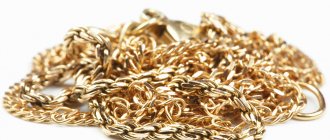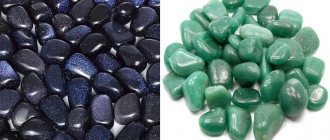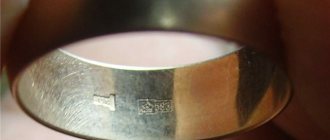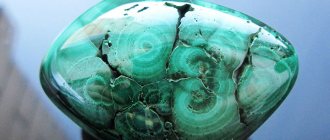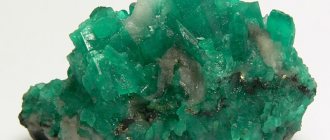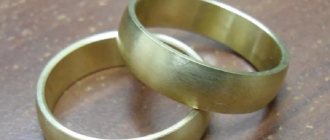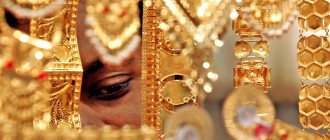A sign of the times is the emergence of more and more jewelry stores, their number is steadily growing, and the quality of the jewelry products offered is increasingly being questioned. But they are made quite skillfully. Even experts cannot always guarantee the authenticity of precious items.
In addition, only a small specific segment of the jewelry is subject to inspection. Having superficially checked the product (no more is required from him), the expert confirms its authenticity and the fake, containing a minimum of pure metal, is sent for sale to the store.
Nobody wants to become a victim of deception and give money for fake jewelry. Then it makes sense to learn how to identify pure gold from counterfeit yourself. First of all, you need to know something about gold itself and its characteristics. Additionally, here you will receive some tips on how to distinguish gold from gilding.
What will help you recognize a fake?
A fake is different from a precious metal, but often the difference is difficult to detect even for a jeweler. But you can determine which jewelry was purchased in a store yourself at home. The following will help you recognize fake gold:
- Vinegar.
- Pencil to stop bleeding.
- Iodine.
- Paper.
- Magnet.
- Other gold jewelry.
Testing gold with vinegar
Expertise from a jeweler is considered the most reliable. A specialist will help establish the authenticity of the product and issue a conclusion.
So, several ways to distinguish real gold from fake.
Acetic acid oxidizes metals, but it will not have any effect on gold. You can put a piece of jewelry in a glass of vinegar and water and see what happens to it. Gold will not make the water cloudy, its color will remain the same, but if a fake was immersed in a glass of acid, the water will become dark, cloudy, and the jewelry will darken.
To be fair, it is worth noting that pure gold is rare. Jewelry is made from alloys. This happens because gold is a very ductile metal.
Iodine will leave a mark on poor-quality jewelry; it can be dark or light yellow. Counterfeiting gold has long become widespread, so the first rule for a buyer is to choose a store that sells precious items.
Testing a gold ring with iodine
The gold-like metal can be identified using a pencil to stop bleeding. You should run a lapis pencil over the decoration, and if a noticeable mark remains, then it is a fake.
Two different decorations can be drawn across a piece of paper. One must be selected for testing, and the quality of the other cannot be doubted. If the stripes remaining on the paper are the same, then the product being tested is of high quality.
To check you will need two gold items. They are visually compared with each other, using a magnifying glass to determine the quality of the decoration.
Where is gold plating used?
Applying a thin layer of gold to the surface is a widespread technique that is used:
- in the jewelry industry for the production of inexpensive, but high-quality and presentable jewelry, dishes and cutlery, and other products;
- in the electronic and electrical industry in the production of parts and components with high performance;
- in architectural design for the manufacture of gilded stucco or wooden decor, baguettes, church domes, etc.;
- in the manufacture of furniture with gilded decorative parts.
other methods
How to distinguish gold from fake? There are several answers to this question; the following will help determine the quality of the product:
- sample on decoration;
- “tooth test”;
- light adaptation.
The first step is to carefully examine the sample on the jewelry. If it is fuzzy, cloudy, and the numbers are poorly visible, it is better to put this decoration aside.
In some cases, the sample is placed on a lock or on a mount. Therefore, it is worth carefully examining the decoration; perhaps there is another sample somewhere.
In films about the Wild West, the question of how to distinguish valuable metal from a fake was not relevant. The coins were checked “by the tooth”. Since gold is a ductile metal, it will leave a small dent on its surface. But if, after such a check, the jewelry turns black at the “bite” site, then this indicates its low quality.
The light and shadow test is the simplest and can be easily done in the store. The precious metal shines equally in the shade and in the sun. If under the rays of the sun the jewel sparkled with new colors, but in the shadow it looked faded and unattractive, then it is a fake.
How to distinguish copper from gold? Very simple. Copper turns green when in contact with water, and it is also more durable and less ductile. It is present as an alloy in precious jewelry, this should not be forgotten.
Gold is not attracted to a magnet.
Checking a gold ring with a magnet
Gilding and methods of applying it
Gold plating is considered to be a layer of several microns on a piece of jewelry made of silver or other metal. Visually, such objects do not differ from gold ones, which is what many designers, artists and jewelry sellers use. With the help of gilding you can create unique objects of art and architectural designs. They even began to use it in cosmetology.
The further use of the jewelry will depend on the thickness of the gilded layer. For example, a 0.05 mm gold coating will withstand up to six months of active wear, after which it will begin to peel off. Therefore, self-respecting jewelry companies strive not to make their goods cheaper, but to make them of high quality, covering objects with a layer of gold plating from 0.1 mm.
There are several ways to gild products. The choice of each of them depends on the type of metal being coated and the professionalism of the craftsman.
- Fire or mercury. An ancient method often used in gilding church domes. It was based on the use of a mixture of mercury, so the method was dangerous to health and even life. Because of this, they stopped using it.
- Oil-based or Mordan gilding. It is used for both internal and external work. Mordan can be purchased in specialized online stores.
- Clay based. Used mainly for interior design and not for decoration. Previously, coating mixtures were made from specially selected components. Now you can find ready-made formulations on sale
- Water-synthetic. For this method of gilding, mixtures based on water are used. The finished product is glossy and does not require final polishing.
Gilding on jewelry is done in a modern way - galvanic. In this case, only high-quality gold is often used. The gilded layer lasts from 3 months to a year, depending on the frequency and accuracy of wear.
How to recognize gilding?
Experts know how to distinguish fake from real gold, but sometimes they make mistakes. Cunning manufacturers do not send a whole product for inspection, but only a part of it, for example, the links of a chain or the lock of a bracelet.
The expert tests the product, and the manufacturer embeds a lock into a piece of low-quality jewelry.
Most often, brass and gold plated are passed off as precious metals. How to distinguish gold from brass? For this you will need:
- ceramic tableware;
- gold product.
The ceramic product must be uncoated. The decoration is passed over it, and if a dark mark remains on the surface of the dish, it means it is a fake. The gold will leave a streak of yellow.
If you need to recognize gilding, you can scratch it behind the film of precious metal: a black stripe will appear, which indicates the low quality of the jewelry.
How to distinguish good quality gold from fake? Temperature will help with this. You need to heat the decoration over the stove. High temperature will not affect the noble metal in any way, but the fake will change: dark stains will appear on its surface.
You can throw the jewelry on a smooth, flat surface. Noble metal will make a characteristic sound, but this method of testing is not suitable for chains and bracelets, as well as long earrings.
How is gilding different from gold?
This question is usually asked by people who are not knowledgeable about jewelry. In fact, gilding is gold, but only applied in a thin layer to another metal. To make the base, you can take silver (most often used by jewelers), steel, copper, tin, aluminum, etc. In principle, gilding can even be applied to stone, plastic or wood, but the manufacturer must indicate this in the document attached to the jewelry.
There are several ways to apply gold plating:
- fire (mercury), widely used in ancient times and extremely dangerous to health;
- mechanical, when a thin sheet of gold leaf is attached to the surface of the product by beating;
- oil (mordan), based on gluing gold leaf onto an oil adhesive base;
- polyment (clay), previously widely used in the manufacture of icons, as well as baguettes and other interior decorations made of wood;
- water-based, used today to cover interior stucco elements.
Modern jewelers most often use galvanic gilding, when a layer of gold is applied to the surface of a product by electrolysis, involving immersing the item in a galvanic bath and passing an electric current through the solution. As a result of an electrochemical reaction, gold is deposited on the jewelry in an even layer.
If a thick layer of gold is required, the fusing method can be used, which involves treating the product with a molten precious metal. This method is used to make expensive and high-quality gold-plated jewelry.
What jewelry should you not buy?
If there is a decoration on the surface:
- Scuffs.
- Roughness.
- Chips.
- Fuzzy sample.
- The product has an uneven color.
Jewelry has a characteristic cold shine. They should be even and smooth, the color of the product should be the same with tints of shade. No dark stains or stripes are allowed.
The higher the standard, the better the quality of the product, but it is impossible to find pure gold in the store. The most popular hallmarks are 585 and 750, these jewelry are of high quality, but the precious metal is mixed with silver, copper and other metals that have no value. All in order to increase the durability of the decoration.
According to experts, gold from Turkey most often turns out to be fake and of low quality. The Turks can test any test for fake gold on the street. Therefore, you should be careful when purchasing gold products and avoid dubious sellers and points of sale. An unscrupulous merchant will never tell the buyer how to recognize a piece of jewelry. He will simply praise his product.
Selection criteria and recommendations for purchasing
The first thing you should know when going to a store to buy gold jewelry is that it must be reputable and certified. It is highly not recommended to buy such products in small shops, kiosks, and especially on the Internet on dubious sites.
You don’t need to trust your intuition and especially chase the cheapest. A suspiciously low price for jewelry supposedly made of gold should be the first signal that it is a fake. All high-quality jewelry made of precious metal must be hallmarked, even if it was made to order.
If you know a jeweler, it is better to ask him to check the authenticity of the selected product. You can use a paid gold determination service. Now they are provided in any specialized stores, workshops and even pawn shops.
Brand
Although scammers have long proven their skill in imitating a government stamp, this is still the first thing you should pay attention to. There is a good chance that not very experienced swindlers will not bother with faking the brand or will not do it very carefully. As for the hallmarking of gold and gilding, the following stamps are accepted in Russia:
- On the gold there is a mark in the form of a spatula with the image of the head of a girl in a kokoshnik looking to the right, and a hallmark. Standard gold samples that can be found in a jewelry store: 375, 585, 750. As a rule, other samples are rare. If the product was made in the Soviet Union, then the hallmark will depict a star, inside a hammer and sickle, and instead of 585, it will be 583.
- Gilding is not marked with any specific marks. If the coating is applied to silver, the mark will have the appearance of silver. The images are the same, only the shape of the stamp is not a spatula, but a barrel. The hallmarks for silver are 925 and 875, it can also be 916 if the product is made in the USSR.
Gilt or gold?
Gold: what is it?
Rare earth precious metal yellow in color. Does not oxidize and does not lose its properties over time. Due to its plasticity and softness, it can be easily processed using both cold and melting methods. Its softness does not allow it to be used as jewelry in its pure form.
To make jewelry, harder metals are added to give it hardness, such as silver or copper. All so-called gold jewelry are alloys.
Any jeweler is well aware of the ratio of gold in the alloy. Some of them, especially unburdened by conscience, use this knowledge for their own selfish purposes. But there are some rules that can help determine whether the gold you are being offered is real or a cheap fake.
Buy gold only in reputable jewelry stores operated by jewelry factories, but not in boutiques and small stalls. The cost will, of course, be more expensive, but there will be less risk of buying a fake.
A real ingot must be marked with data about the sample. A careful study of the tag will tell you about the manufacturer, the price per gram and for the entire jewelry as a whole, weight, sample. There must be an OTK stamp. The sample indicates the content of pure gold in the jewelry.
The most popular are 585 and 750. This means that they contain 58.5% and 75% pure gold, respectively. When the sample is found, you should carefully examine the clasp of the bracelet or earring. If there are scratches on them, then you should not take this product.
The reason here is the following. In bracelets, chains and earrings, the sample is placed on the clasps. And suppliers only send locks for inspection and, after inspection, calmly place them on gold-plated fakes.
Finally, you should find the logo or imprint of the manufacturing company on the reverse side of the jewelry. The method described now relates to the visual assessment of gold.
But this is also not an indicator of reliability, since in Turkey, for example, they can give you any test before your eyes. Yes, and not only there. A fuzzy, blurry sample is the first sign of a fake; such gold should not be taken. The second detail that you should pay attention to is the inside of the product, which should be perfectly mirror-like, without any irregularities or roughness.
